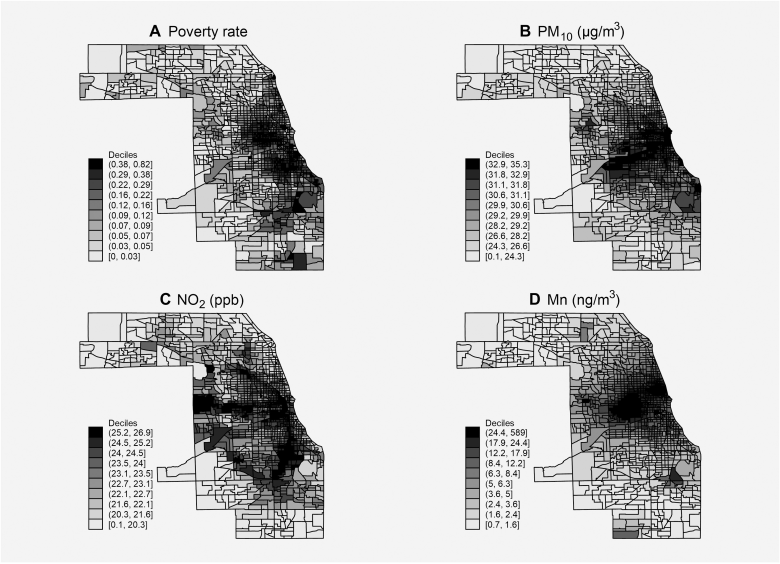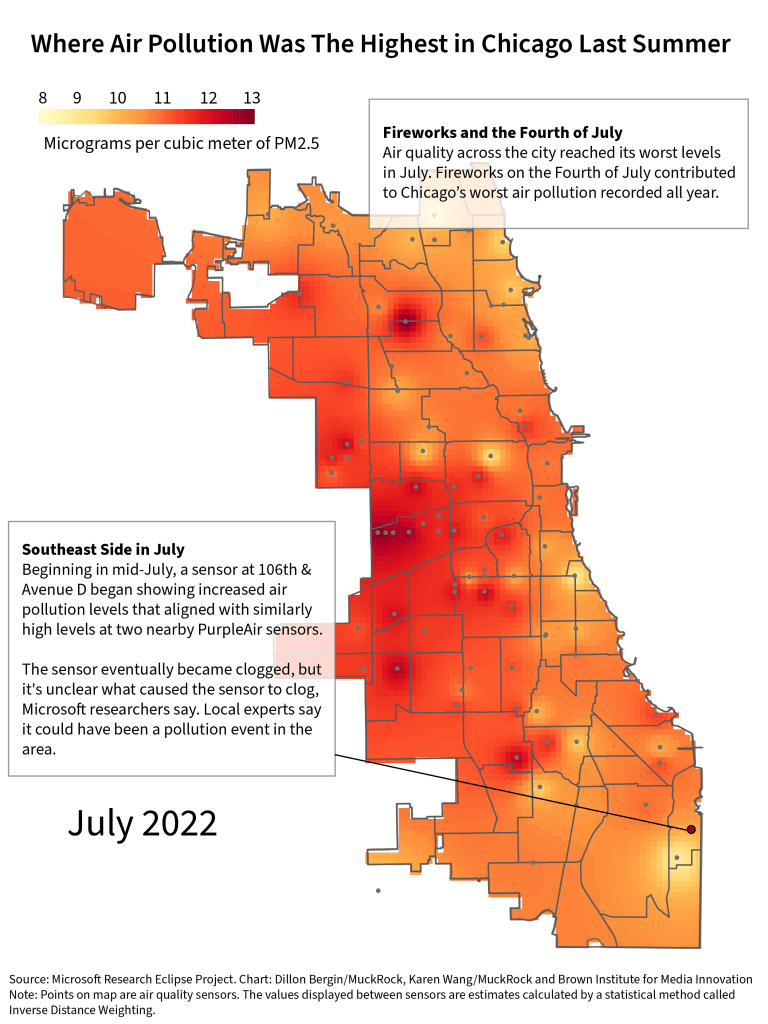The United States stands out among economically advanced democracies for the depth and expanse of its poverty. Concentrated poverty in particular is among its most disturbing and persistent problems. The problem deepened in recent decades as income inequality increased and lower-income families became more spatially isolated from those with higher incomes. Analysis by the American Association for the Advancement of Science (AAAS) indicates that growing up in a poor neighborhood leads to diminished cognitive abilities, lower levels of educational achievement, and worse economic fortunes in adulthood.
According to the study, young children living in neighborhoods with high rates of poverty are more likely to be exposed to many different air pollutants, and that can harm their development during early childhood.
Worst Air Pollution Found In Communities Of Color
MuckRock, a journalism non-profit looked at air quality across Chicago and found troubling levels in several South Side neighborhoods. Analysts also found that the worst air pollution levels in areas with Microsoft sensors were largely those in communities of color.
Meleah Geertsma, director of environmental justice policy for the Natural Resources Defense Council, a nonprofit environmental advocacy group, said that it is not surprising that sensor networks are picking up elevated levels of pollution near industrial areas and associated traffic corridors.
“Moreover, all too frequently high levels of pollution such as seen here occur in low-income and BIPOC communities, which are also more vulnerable to such pollution,” she said. “Chicago needs to address these systematic disparities and injustices.”
In response to MuckRock’s findings, the Chicago Department of Public Health (CDPH) said in a statement that although they are unaware of any specific pollution event on the Southeast Side in July, they do respond and investigate citizen complaints and inspections of facilities that hold air pollution permits. “We are in the beginning stages of building out a system to actively ingest, analyze and utilize such data.”
The Illinois EPA operates 11 monitors for particulate matter in Cook County. So far in 2022, none of these monitors have detected pollution levels that exceed national air quality standards, MuckRock reports.
The AAAS research focuses on Cook County because it is a large urban setting that suffers from both concentrated poverty and air pollution from multiple sources.

(A) The poverty rate, (B) concentration of PM10, (C) concentration of NO2, (D) concentration of Mn Data
Several patterns are evident in these maps. First, poverty is concentrated mainly on Chicago’s South and West Sides, in several pockets on the North Side, and in several suburban communities located to the south of the city. Many of these neighborhoods are also predominantly Black or Hispanic, reflecting the city’s history of extreme racial segregation.
Second, NO2, which arises mainly from vehicle emissions, is concentrated along the major expressways that traverse the city. Because the expressways tend to abut neighborhoods with relatively higher poverty levels, these factors—NO2 and concentrated poverty—appear weakly correlated.
Third, PM10 also appears weakly correlated with neighborhood poverty, as this pollutant is disproportionately concentrated in the South and, to a lesser degree, the West side of the city.
Fourth, Mn, a neurotoxic heavy metal that arises mainly from manufacturing facilities, is concentrated in several industrial sections of the metro area that tend to be located in or near relatively poorer neighborhoods.
Last, although concentrated poverty and the distribution of these toxins are associated in Cook County, neighborhoods with low poverty levels and high pollutant concentrations still exist in nontrivial numbers throughout the area.
Effects Of Poverty On Cognitive Ability
It has long been known that poorer communities are disproportionately exposed to air pollution than more-affluent communities, but the study reveals the ways cognitive gaps are formed as early as 6 months and are entrenched by age two.
The children’s increased exposure to air toxins during infancy can reduce their ability to comprehend complex, fundamental, integrative learning skills and cause them to fall behind — for some, the effect is equivalent to losing an entire month of elementary school.
“The study is showing that children born into high-poverty neighborhoods are more likely to be exposed to many neurotoxic air pollutants and that those differences, in turn, are linked with inequalities in early-childhood development, specifically reading and math abilities measured around the time of school entry,” Geoffrey Wodtke, associate director of the University of Chicago’s Stone Center for Research on Wealth Inequality and Mobility told The Washington Post. Specifically, the findings indicate that early life residence in a neighborhood with a poverty rate of 25 percent, rather than 5 percent, reduce reading and math skills.
An important policy implication of the Concentrated poverty, ambient air pollution, and child cognitive development study is that interventions designed to improve environmental health may also promote upward social mobility. That is to say that environmental policy may also function indirectly as an anti-poverty policy, and these second-order effects should be accounted for in cost-benefit analyses of any program aimed at cleaning up the physical environment or otherwise reducing exposure to toxic hazards.
Cover Photo: Mike Wojan



